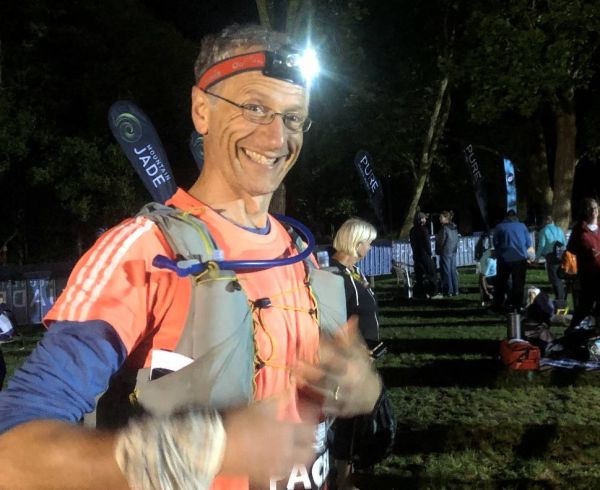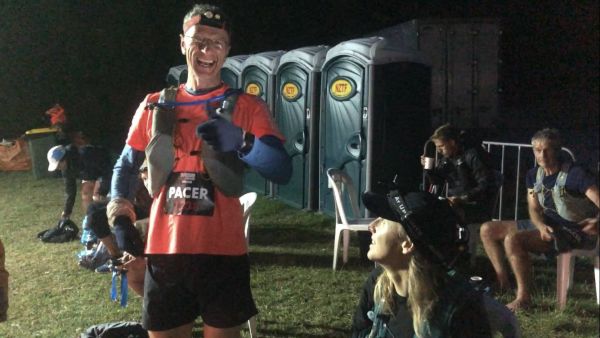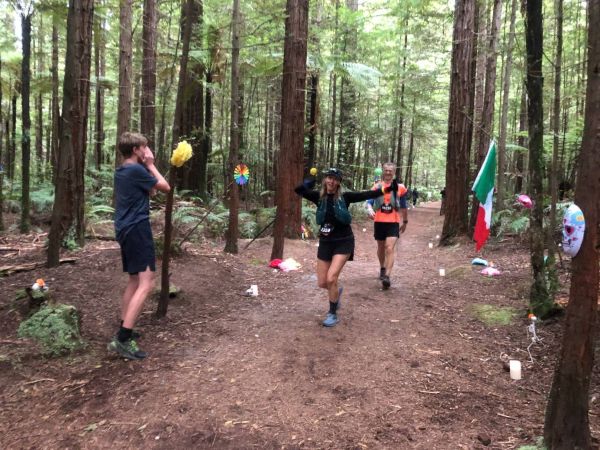Come quick, go slow, don’t stop ‘til Vegas – tales of an emergency pacer

Jeremy Boase
March 3, 2023 11 min readJeremy Boase was a pacer in the Tarawera Miler in February. This is his story.
The email said “Just sending out an SOS. Need to ask a massive favour. Let me know if/when you’re free for a quick chat.”
The email was from a friend, colleague, and running buddy. A friend who, after two years of preparation and one Covid-cancellation, was due to race the Tarawera Miler in just three-and-a-half-weeks’ time.
The follow-up email said, “You can probably read between the lines!”
A couple of hours later our diaries had freed up and Debbie confirmed what was between those lines: her pacer needed to step out and, absolutely no pressure, but could I step in?
Yes, of course, I instinctively replied. A more rational assessment would have considered the fact that I had never run more than a marathon, had never run through the night, had never been part of the Tarawera hoopla, and had never been a pacer. An obvious choice then.
On the other hand, I had already signed up to be part of Debbie’s support crew for the race so was available for the weekend, was comfortably three-hour-run fit, had a decent base of trail running over the last couple of years, had previously run a couple of very long training runs with Debbie, and was confident that with over 100 kilometres in her legs when I started I should be able to match her desired speed. Let’s do this.
Then I thought, let’s do what exactly? What does a pacer do? How does a pacer prepare? What are the biggest mistakes to avoid? Well, that one’s probably easy: falling over, going the wrong way, going too fast, not finishing. I felt like I had a lot to learn and not much time to learn it.
So I did what we do and consulted the Google-sphere. Which didn’t start well. Chuck in ‘pacer’ and ‘running’ and there are a bucket-load of responses about getting someone to a quick 1500 metres or breaking marathon PBs (well that’s not happening in the back-end of an ultra) but not much about wandering through the Rotorua hills at night with a zombie who already had over 100 kilometres in their legs.
Add ‘ultra’ to the search and there are better pickings (duh). As with all good advice, the key messages were the obvious ones: be positive, know the course, know your runner’s nutrition plan, encourage but don’t berate (unless that’s the only thing that gets your runner’s juices flowing), and the one that wasn’t instinctive, look after myself. While at face value it was ‘all about Debbie’, to make sure I was more help than hindrance I had to make it a little bit about me. I needed to make sure my head was in the right place, my kit was comfortable, my nutrition plan was sensible, and my drop bag had all the things I might need but probably wouldn’t. Fair call.
Part two of the research was to spend several evenings consuming YouTube videos to get into the Tarawera vibe and to get some insight on the course (the Western Okataina can be added to the above list of potentially helpful things that I had never done).
From the sublimely moving and inspirational Chasing Pounamu to the shakiest hand-held selfie with appalling background music, I watched the lot. Unfortunately, but not unreasonably, they all seem to focus on the athletes and not the other guy or gal in the frame, the pacer. And because the Western Okataina is typically run in darkness by most YouTubers, there was very little useful footage of that too. So, unless there was some subliminal stuff that I missed, while this was great fun and hugely stimulating, it wasn’t much cop in the ‘directly helpful’ category.
A chat with a couple of experienced local pacers was more encouraging, though much of their advice was along the lines of ‘you’ll be fine’ and ‘just get her to the finish’ and ‘don’t get lost’ which wasn’t really hitting the deep insight target I was hoping for. Despite this, I was getting more confident that this pacer malarkey was going to be doable and fun.
And then things got wobbly. First, another big storm rolled through, dumping even more rain on the sodden isle. Then a spider bite turned infected and required large bandages, a week of antibiotics, and a total break from running, stymying my planned recce of the course. Then, at the beginning of race week, the big one, the closure of the Eastern Okataina Walkway, the agonising two-day wait for a Plan B, and then the announcement of the much revised, two lap course.
Like everyone else I searched through the announcements for hints as to what it meant for me. The upshot? The pacer role just got bigger, the fruitless search for clues about the Western Okataina no longer mattered, and now we had a new stretch of the course that I wasn’t remotely familiar with. Everyone says a miler is all about problem solving and so it seems, even before it starts.
Race day. The gun went at 4.20am. I woke three hours later and 80 kilometres away. And for the first of many, many times, checked the race app to see how Debbie was going.
Apart from the avid phone-watching, my Saturday was very non-Tarawera (though my wife might reasonably disagree given my distracted, somewhat anxious demeanour and I will acknowledge that the afternoon sleep was both a rarity and a huge luxury). And then, when the app and various scouts told me that Debbie was approaching the Tikitapu aid station, it was off to Rotorua to share in the grand adventure.
Before I start recounting bits of the next 12 hours, it should be noted that I had it easy. Debbie is a very determined, strong-willed, focused person who was always going to finish her first miler. She is also hugely personable with a great sense of humour and has a busy but balanced life with what I consider to be the right priorities, family being the first by some distance. In short, if you were to spend a long and potentially painful night on the trails with someone, you could do a lot worse.
Once at the Village Green, the enormity of what Debbie had already done and therefore the bigger-than-enormity of what was to come, began to sink in for me. Tales of a couple of tumbles, bloodied elbows, a tight iliotibial band, and knee pain were supplemented by the sight of the medics draining and bandaging a nasty foot blister. And we’ve still got 60 kilometres to go. I may have been there to exude confidence as we started lap two but a kaleidoscope of butterflies were munching away on my innards.
And then, without apparent warning, we were off. Just the two of us with a full night of questions ahead of us.

Jeremy, full of energy (and nerves) at the Village Green.
Prepping for the race, I had a feeling that the trip out of town to the next aid station at Hemo Gorge would be tough: away from friends and family, concrete and bitumen under foot, darkness now set in, and with the dreaded second lap over familiar territory looming. But we settled into an easy rhythm, chatted through the day’s events, and made pretty steady progress. We got to Hemo in about the same time as Debbie did on the first lap.
It was a good start but we both knew the night would only really begin when we left Hemo. Then it would be 34 kilometres and six or seven hours before we saw the crew again at Tikitapu. Time to go to work. Time to figure out what this ‘work’ involved. Time to answer some of those questions.
For a start we quickly sorted the ‘where does a pacer run?’ question. We had no pre-conceived plan and didn’t talk about it at the time, but it soon became apparent that my role was usually to be between four and eight metres ahead of Debbie with a big target plastered across my back. That way I handled navigation (which was not tricky as the course was superbly well marked) and, as the night wore on and legs became even more tired, identification of track debris to avoid or jump (!) over. The one time we swapped places, coming out of the Rotokakahi aid station, the increased stress of following the reflective tape through the first couple of corners resulted in a quick swap back to normal service.
The ‘how do you know how fast to go?’ question was also fairly easily answered: as fast as I wanted until I lost the tip-tap of Debbie’s poles in my ears. We jogged a fair slice of the flats and downs for the first 30 kilometres of the night, but walked all the ups, using the chance for some side-by-side company and conversation. Then, as the ground levelled, I would break into a gentle trot and keep alert for the tip-tap-tip-tap behind me and for my own shadow in front of me. Lose one of those and we kept going; lose both and it’s time to slow down and wait for the proverbial bungy cord between us to shorten again.
Back at the Village Green Debbie and her crew had told me that she was having trouble taking food. This created a new role for the pacer as ‘food cop’. This one wasn’t easy. While some calories were going down via the Pure race-drink, Debbie was acutely aware that she ought to be eating more. But being aware and being able to action that awareness were two very different things.
One of my early mentions of it being time to eat something brought audible dry retching from the darkness four to eight metres behind me. Not a good start. Balancing the logical instinct to push my point with the empathetic instinct to shut the hell up and leave her in peace occupied my mind for a couple of kilometres until I finally came to my senses: if she doesn’t eat, she doesn’t finish. So ‘bad cop’ it was and the gentle but too-persistent-to-ignore coaxing continued. As did the dry retching.

Delighted to have made it to Tikitapu
If that part of the role was a struggle, one playing more to my strengths was Captain of Maths.
Debbie had started with a time goal and had created a tidy buffer in the early hours of the race that she had held steady through to the end of the first lap. However, the unwilling stomach and the development of what became a medically impressive open sore on the base of one foot added to the physical woes that she had accumulated in the first 100 kilometres. In the depths of the night and at the low point of her own emotions she vocally and forcefully dropped the time goal in favour of ‘just getting there’.
But I didn’t.
I kept an eye on the kilometre splits, made notes and calculations at each aid station, and maintained a strong walking pace that should get us home under the goal. And all while keeping my mouth shut – I was learning. Helping my conniving was the fact that Debbie’s watch had died at about 120 kilometres (cue short-term Strava-angst) meaning I was the sole arbiter of time. This left me free as to the what and the when of any disclosure to my audience. Which was not very much. So little in fact that when we finally got to the Redwoods aid station, just 7 kilometres from the end, and one of her crew told Debbie that she was on track to smash her time goal her disbelief, and then tired delight, was wholly genuine. Tick.

Temporary back-seat driving at the Redwoods aid station
An unexpected role, and probably a sub-set of the stay positive category, was as ‘celebrator of milestones’. It goes without saying that the final 60 kilometres of a miler are a long way. Breaking it down into achievable chunks is necessary. Aid stations are obvious success markers but finding other small reasons to smile and celebrate along the way became hugely valuable. So we recognised Debbie’s longest ever run, midnight when she officially became a ‘multi-day racer’ (as did I though starting at 9-30pm felt a little like cheating), 24 hours since breakfast, 24 hours of running, the first glimmer of dawn, my longest ever run, my first 50, passing 150 kilometres, and probably one or two others I’ve now forgotten. Each provided a welcome energy lift.
As the night gave way to the almost-dawn, the role of the alarm clock kicked in. About thirty-five minutes before Blue Lake I messaged the crew to tell them we were close, a handy heads-up for the Crew Chief parked there in the campervan and a rude chase-up for the other three who were in accommodation 30 minutes away.
They made it, just, much to Debbie’s delight and their relief.
With everyone awake, the updates over the last 18 kilometres became increasingly regular: health and location updates, food orders for the last aid station (a flat white for me, ‘something from Maccas’ for Debbie). And then the steady countdown for the crew and various friends who had run their own races on the Saturday: ‘at the hotel now’, then ‘past Polynesian spa’, then ‘onto the grass. 1.5k or so to go. 15 minutes perhaps’, and finally the simple ‘finishing chute’. Debbie turned left and headed for the glory of the tape and her family’s embrace; I bailed right and joined the adoring crowd.
And that was that. Job done. Whew.
Final thoughts? The overwhelming one is of privilege. It was a privilege to have been asked, a privilege to have been trusted. And it was a huge privilege to experience at close-hand a friend do something incredibly special. Thank you Deb, and massive congratulations.


